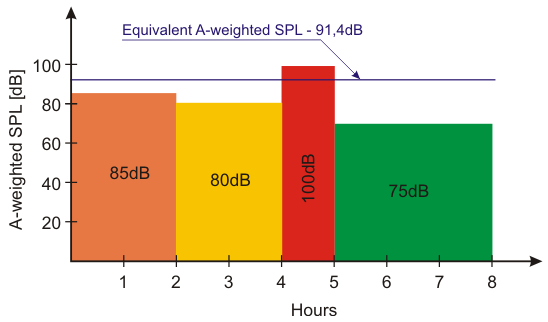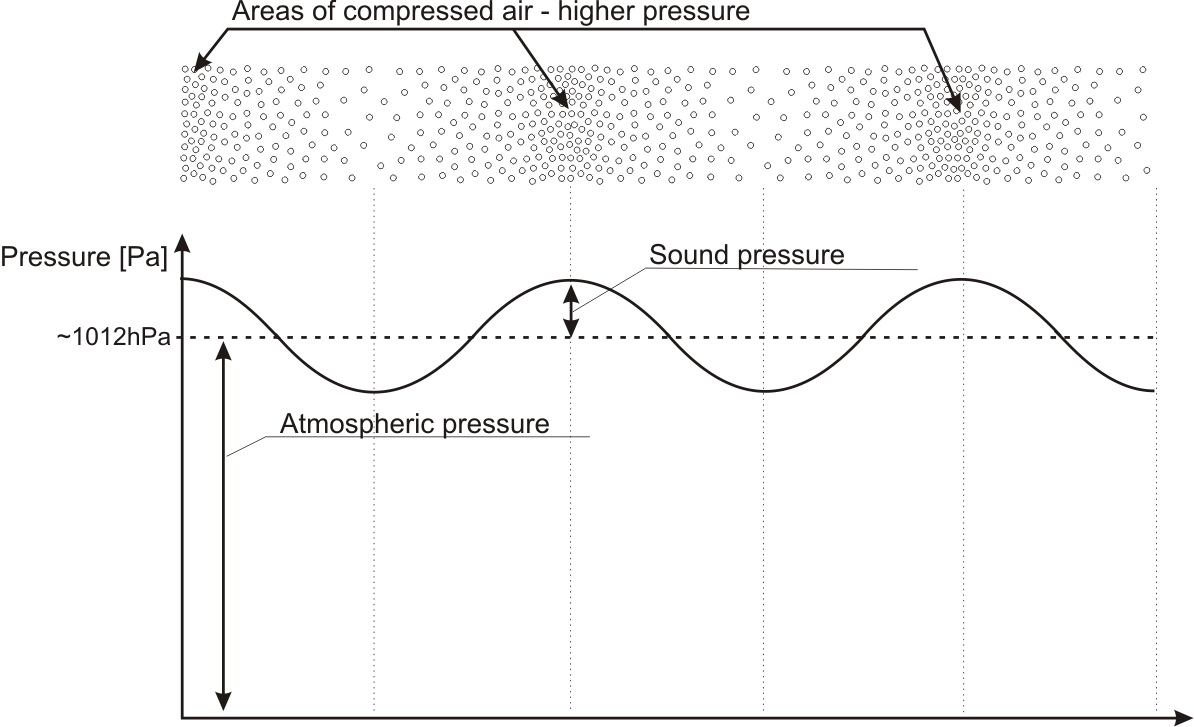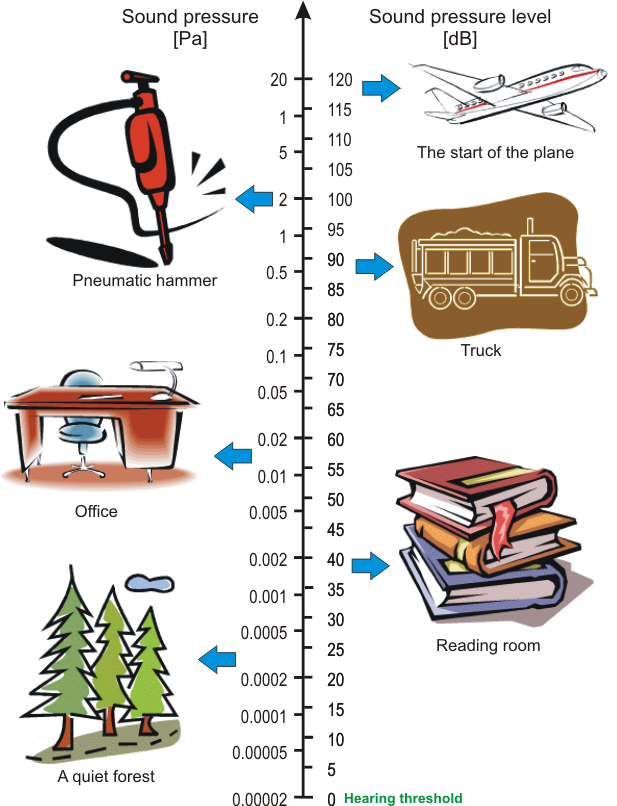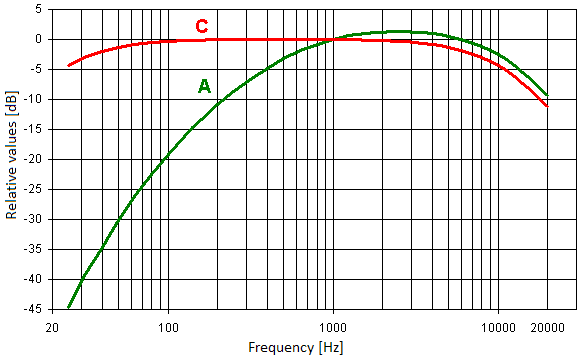Misją Instytutu jest dzialalność naukowo-badawcza prowadząca do nowych rozwiązań technicznych i organizacyjnych użytecznych w kształtowaniu warunków pracy zgodnych z zasadami bezpieczeństwa pracy i ergonomii oraz ustalanie podstaw naukowych do właściwego ukierunkowywania polityki społeczno-ekonomicznej państwa w tym zakresie.

BASIC CONCEPTS RELATED TO NOISE IN THE WORKING ENVIRONMENT
Sound
Sounds are the vibrations of air particles (or other elastic medium) in relation to the equilibrium position. These vibrations propagate in the air in the form of acoustic waves, i.e. consecutive compression and rarefaction of air particles. The speed at which vibrations of air molecules spread is called the speed of sound which is approximately 340 m / s. The space in which acoustic waves propagate is called the acoustic field. Sources that cause air molecules to vibrate (sound sources) can be various types of vibrating objects, machine elements, air flow (eg as in a whistle), impacts. The phenomenon of sound generation and propagation is shown schematically in Fig. 1.
Sounds can spread not only in the air but also in other elastic bodies, eg in steel, concrete, etc. Sounds in the air are called air-borne sounds and sounds are propagated in solid materials with structure-borne sounds.
Frequency
Frequency, denoted by the symbol "f", is one of the two basic parameters describing the sound, which determines the number of periods of vibration that air particles perform per unit of time. The frequency unit is Hertz [Hz].
The human ear is able to detect sounds with frequencies in the range 20 Hz to 20 kHz (1 kHz = 1000 Hz). Such sounds are called audible sounds. The sounds of frequencies below 20 Hz, which are not audible to human beings, are called infrasound and the sounds with frequencies above 20 kHz are called ultrasounds (Figure 2). The term “noise" usually correspond to the audible sounds (in contrast to “infrasound noise" and "ultrasonic noise").
Audible sounds can be divided into low- medium- and high-frequency ones, however the boundaries of these divisions are smooth. Low frequency sounds are perceived by people as bass sounds and high frequency sounds as sopranos.
Sound pressure
Compressions and rarefactions of air particles resulting from the propagation of sound cause small changes in pressure in these air areas. In places where the air particles are compacted together (Fig. 3), the air pressure is slightly higher than the atmospheric pressure, while in places where they are more spread the pressure is lower than the atmospheric pressure. These small changes in pressure are called the sound pressure marked with the symbol "p". The unit of measure of sound pressure is Pascal [Pa]. The higher the vibration amplitude of the sound source and the air molecules, the higher the sound pressure. Sounds with higher sound pressure are perceived by people as louder, for example: whisper - 0.0003 Pa, vacuum cleaner - 0.05 Pa, pneumatic hammer - 10 Pa
The quietest sound that a person with healthy hearing can hear is about 0.00002 Pa or 20 μPa. Sounds above 20 Pa already cause ear pain.
Sound pressure level
The sound pressure of the quietest and loudest sounds that can be identified by humans differ more than a million times. For this reason, in practice, the logarithmic scale and the notion of sound pressure level as a relative value related to 20 μPa and expressed in decibels [dB] are used for sound description. The sound pressure level L of the pressure p is determined based on:
where p0 is the reference pressure.
The value of the reference pressure was assumed to be equal to 20 μPa and is the sound of the most quiet sound a human being can hear. In practice, this means that the sound pressure of 20 μPa has an acoustic pressure level of 0 dB, and eg sound with a pressure of 2 Pa has a level of 100 dB. Examples of sound pressure values and corresponding levels are shown in Fig. 4
Weighted sound pressure levels – A and C weighting curves
The human ear reacts differently to sounds with different frequencies. At low sound levels, it is best to receive those with frequencies from 2 to 4 kHz. The human ear features make the sound at 2 kHz and the sound pressure level equal to 30 dB appear as loud as the 100 Hz sound and the level of about 50 dB. The higher the sound pressure levels, the smaller the differences. To take into account the sensitivity of the human ear to sounds, weighting frequency curves were introduced to the quantities describing sound. The most commonly used - A and C are shown in Figure 5.
The sound pressure level corrected according to the frequency curve A is called the A-weighted sound pressure level, and the sound pressure level corrected according to the frequency curve C - the C-weighted sound pressure level
The A-weighted sound pressure level.
It often happens that an employee performs work on various machines that generate noise at different sound pressure levels during a work shift. In this case, to determine the risk for an employee exposed to noise during the change, an equivalent A-weighted sound pressure level should be calculated.
Equivalent A-weighted sound pressure level is the A weighted sound pressure level that operates for the same time as noise with varying sound pressure level, it carries with it the same energy and the same risk of hearing damage. Fig. 6 shows an example of changes in A-weighted sound pressure level of noise during an 8-hour working day. The employee worked for the first two hours in noise with a A-weighted sound pressure level of 85 dB, the next two hours in noise with an A-weighted sound pressure level of 80 dB, then an hour in noise with an A-weighted sound pressure level of 100 dB and three hours in noise with A-weighted sound pressure level equal to 75 dB. From the point of view of occupational exposure, this corresponds to a situation in which an employee would work eight hours in noise with an A-weighted sound pressure level equal to 91.4 dB.

Fig. 6. Changes of A-weighted sound pressure level in a 8-hour working day and corresponding equivalent A-weighted sound pressure level.
For non-stationary moise, in which there are clearly distinguishable, fixed A-weighted sound pressure levels, the equivalent A-weighted sound pressure level can be calculated from the formula:
where:
LAeq,Ti - equivalent A-weighted sound pressure level averaged over time Ti,
n - total number of clearly distinguishable levels, LAeq,Ti
- total exposure to noise time.
If A-weighted sound pressure level (LA)of noise for a specified time Ti does not change, the equivalent A-weighted sound pressure level (LAeq,Ti) for this time it is equal to the A-weighted sound pressure level (LA).
Exposure and noise exposure level
The harmful effect of noise on hearing depends on the amount of sound energy reaching the employee's ears, and therefore on the level of noise pressure and the time of its impact. To assess the harmful effect on the hearing organ that changes over time, a quantity called daily noise exposure was introduced, along with the corresponding daily noise exposure level that is more commonly used in practice.
The daily noise exposure level is defined as the equivalent A-weighted sound pressure level determined for the time of exposure to noise equal to the standardized working 8-hour time and defined by the formula:
where:
LAeq,Te - equivalent A-weighted sound pressure level determined for exposure timei Te,
T0 - reference timea = 8h,
It is worth noting that when the exposure time Te is equal to the reference time T0 ci.e. the 8-hour daily work time, then the daily noise exposure level LEX,8h corresponds to an equivalent A-weighted sound pressure level, LAeq,Te:









